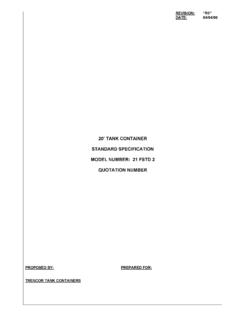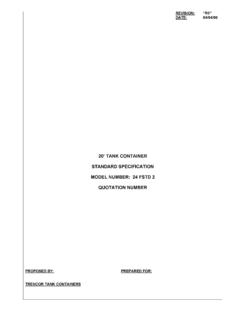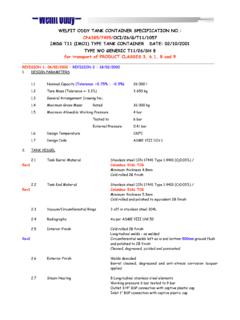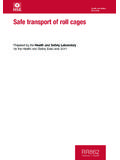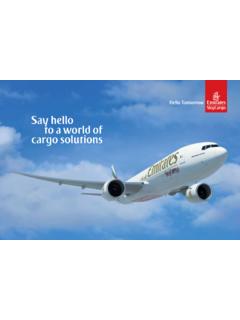Transcription of Operating the tank safely Product handling The tank ...
1 Operation Hazardous Cargoes DangersHandling Cleaning Gas BlanketingHeating MiscellaneousFault Finding Operating the tank safely Product handling The manufacturer of the Product can be contacted for advice and information on the appropriate safety standards. Required protective clothing may consist of part or all of the following depending on the protection, apron, trousers or suitBoots, clogs or overshoesGlovesEye protection, visor or glassesSafety helmet and/or hoodVapour mask or breathing apparatusThe protective clothing must be resistant to the type of Product being handled The safety of operatives, the general public and the environment depends upon the responsible operation of tank containers during loading, discharge, storage and is essential to ensure the following before loading or dispatching a tank container. The tank is the correct type and in the proper mechanical condition The tank interior and exterior is suitably cleanEnsure that the tank container being used is suitable and approved for the carriage of the cargo concerned and has been well maintained, inspected and tested in accordance with the regulations.
2 It should also have successfully completed Pre-trip to view pre-trip inspectionEnsure that any residue from previous cargoes is removed or is compatible with the Product to be loaded. The exterior of the tank, especially the labels and markings, must not be contaminated or obscured with cargo spillage. The gross weight is not exceededThe gross weight of the vehicle when loaded must not exceed the weight limitations imposed by regulation. The tank is labelledThe correct identification and hazard warning labels must be attached in their appropriate positions on the container. Labels which are no longer applicable must be removed. All operations are competently supervisedThe personnel in charge of loading or discharge must be in possession of written instructions detailing the safety requirements and emergency procedures in relation to the handling of the cargo and must have been trained to the required level of competency. The tank is filled correctlyThe ullage (free space in loaded tank) must comply with the to view ullage claculations The gas or air supply is cleanEnsure that any gas / air supply used for loading, discharge or blanketing will not contaminate the cargo.
3 Suitable equipment is availableThe loading or discharge equipment (hoses, couplings, gauges, pumps, compressors etc) are in good order and suitable for the Product to be handled. 5/12/02 11:17 amTankspan - Safety - OperationPage 1 of 1 strongly advise the operator to carry out a pre-trip inspection before the tank is filled with cargo. It is also in the operator's interest to arrange for intermediate external inspections at selected ports and depots to report and pinpoint the cause of any damage to tank containers in transit. The following minimum inspection procedure is provided for the operator's guidance. The inspection as described is advisory only and it may be found that different procedures are necessary depending on the cargo and on the circumstances under which the tank is used. It is in the operator's own interest to maintain the tank container in perfect operational order. Apart from the consideration of possible legal repercussions following an incident involving badly maintained tanks, effective preventive maintenance minimises non-productive time and repair costs.
4 All defects should be reported to the engineer in charge of repair and maintenance. If further investigation or tests are required these should only be carried out by a qualified personnel trained in the maintenance and repair of the items considered damage should only be repaired by approved and competent repairers who are aware of the special techniques and exacting standards required. In the case of major damage to the frame or any damage to the tank shell always consult Tankspan before proceeding with repair. 5/12/02 12:25 pmPre-trip InspectionPage 1 of 1 An increase in cargo temperature due to higher ambient temperature or cargo heating will result in cargo expansion and an increase in vapour pressure. If the tank is overfilled, Product could escape through the relief valve. If the loading temperature is known and the highest temperature the cargo will reach either naturally or by heating is also known, it is a simple matter to calculate the maximum safe load necessary to avoid discharge through the pressure relief hazardous cargo transportation certain maximum filling ratios are recommended by the IMDG Code.
5 These filling ratios are variously 97%, 95% or 90% according to the classification of the cargo or its vapour pressure, or whether the cargo is heated in transit. To calculate the maximum safe load:V = A x C 100 (1+Et)V = Volume of liquid to be loaded (gallons or litres)C = Capacity of tank (gallons or litres)A = Fill percentage requiredE = Cubical expansion co-efficient of liquidt = Rise in temperature of cargo during containmentThis calculation neglects the volumetric expansion of the vessel due to the rise in temperature. For all normal purposes this calculation will be adequate. For certain dangerous liquids definitive filling limits are specified by regulation (refer to the IMDG code). Where5/12/02 12:28 pmUllage CalculationsPage 1 of 1 OperationHazardous CargoesDangersHandling Cleaning Gas BlanketingHeating MiscellaneousFault Finding Hazardous Cargoes Class 1 Class 2 Class 3 Class 4 Class 5 Class 6 Class 7 ExplosivesGasesInflammable LiquidsInflammable solids or substancesOxidising substances (agents) and organic peroxides Poisonous (toxic) and infectious substancesRadioactive Hazardous materials are classified according to the nature of the hazard involved.
6 The most widely accepted system is that promulgated by the United Nations and which is incorporated in the International Maritime dangerous Goods Code (IMDG) and provides the foregoing classificarions for tank containers. Class 1 Explosives Class 2 Gases Substances and articles which have a mass explosion hazard (a mass explosion is one which affects virtually the entire load almost instantaneously) Substances and articles which have a projection hazard but not a mass explosion hazardSubstances and articles which have a fire hazard and either a minor blast hazard or a minor projection hazard or both, but not a mass explosion hazard Substances and articles which present no significant hazard very insensitive substances which have a mass explosion : liquefied or dissolved under pressure or liquefied by refrigerationInflammable* gases Non-inflammable gases Poisonous gases** 'inflammable' has the same meaning as flammable** Poisonous gases which are also inflammable should be segregated as Class 3 Inflammable Liquids Class 4 Inflammable solids or substancesLow flashpoint group of liquids having a flashpoint below - 18 deg C (0 deg F), closed cup test Intermediate flashpoint group of liquids having a flashpoint of - 18 deg C (0 deg F) up to, but not including 23 deg C (73 deg F), closed cup testHigh flashpoint group of liquids having a flashpoint of 23 deg C (73 deg F) up to, and including, 61 deg C (141 deg F), closed cup Inflammable solids Substances liable to spontaneous combustion Substances emitting inflammable gases when wet(Certain inflammable solids, when molten, may be carried in tank containers.)
7 An example is molten sulphur which is in hazard Class ) Class 5 Oxidising substances (agents) and organic peroxides Class 6 Poisonous (toxic) and infectious substancesOxidising substances (agents) Organic peroxides(These are similar to oxidising substances but are additionally extremely unstable and heat sensitive in that an explosive reaction can occur if exposed to heat or if contaminated by reducing agents. Because of the facility to control temperature in transit, tank containers are an effective means of transporting organic peroxides). (toxic) substances Infectious substances(The majority of toxic substances require a Type 1 tank. For certain products a bottom opening is prohibited and a bursting disc may be required in series with the pressure relief device). 11:18 amTankspan - Safety - Hazardous CargoesPage 1 of 2 8 Class 9 substancesCorrosivesMiscellaneous dangerous substancesClass 7 Radioactive substancesClass 8 Corrosives (The majority of corrosive substances require a Type 1 tank.
8 For certain products a bottom opening is prohibited and a bursting disc may be required in series with the pressure relief device). Class 9 Miscellaneous dangerous substancesThis is an abbreviated summary. The UN 'Orange Book' or the IMDG code should be consulted for full information. 5/12/02 11:18 amTankspan - Safety - Hazardous CargoesPage 2 of 2 OperationHazardous CargoesDangers handling Cleaning Gas BlanketingHeating MiscellaneousFault Finding Flash SpillAsphyxiation/poisoningHose WhiplashChemical ReactionAccidental DischargeOverpressureExcessive SteamPressureVacuum CollapseHoses Kinked/flattenedHeat DamageCargo VapourTank OverheatingFlash SpillAsphyxiation/poisoning Hose WhiplashChemical ReactionAccidental cargo DischargeOverpressure COMMON DANGERST ankspan tanks are extremely safe for all modes of transport, and provide secure and robust cargo containment in transit. The greatest risk of cargo spillage or damage to the tank or its fittings occurs during loading and discharge.
9 Here are some common dangers to be avoided. Flash SpillOpening manhole or hose connection when tank is pressurised. May result in 'flash spill' of Product and lid or cover being Examine pressure gauge if fitted and relieve any pressure before opening manlid or hose connection by carefully opening the air-line valve or cap. Take care not to vent off dangerous vapours into the Asphyxiation/PoisoningEntering tank with oxygen depleted or contaminated atmosphere. May cause poisoning or Check cleaning certificate and last cargo. Check tank atmosphere with appropriate analyser before entry. If necessary, carry out gas-freeing procedure. A second person should be stationed outside the manhole with a lifeline to the person in the Hose WhiplashDisconnection of hose when the tank is pressurised. Could cause injury to Ensure that tank and hose are de-pressurised before Chemical Reaction/ Product ContaminationTank and fittings not efficiently cleaned of previous Product .
10 Product loaded in uncleaned tank. Incorrect cleaning agent used. May result in contamination of new cargo violent chemical reaction, crusting/congealing of residues in tank and fittings, or damage to tank Ascertain previous Product carried. Check cleanliness of tank outlet valve chamber and other fittings in contact with cargo before loading. Check cleaning agent compatibility before Accidental Cargo DischargeCareless opening of outlet valve or disconnection of hose from tank containing cargo or leakage via incorrect fittings or hoses. May result in a chemical reaction, toxic or inflammable fumes or other potential dangers to personnel and equipmentCause Check if cargo is present before opening valves or disconnecting fittings. Check that hoses and fittings are correct for a particular Overpressure5/12/02 11:18 amTankspan - Safety - DangersPage 1 of 2 Steam PressureVacuum CollapseHose Kinked or FlattenedHeat DamageCargo Vapour ExplosionTank OverheatingExcessive Operating pressure.
